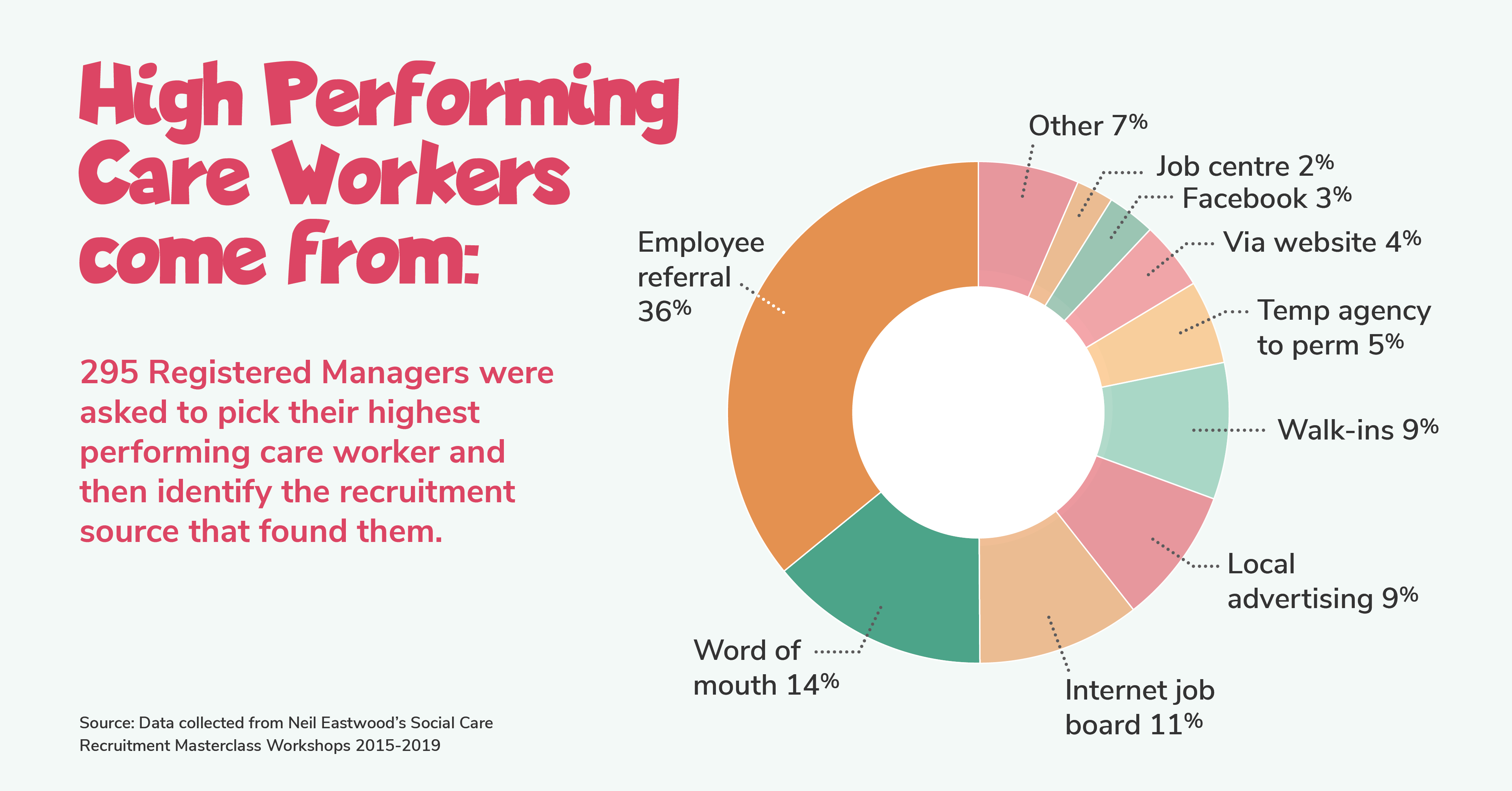Findings from five year study on high-performing care staff
It’s too easy when recruiting social care staff to focus on quantity over quality, and on the short term, not the long term – how many applicants have I got in my pipeline today? Will I fill next week’s training course? It’s too easy to forget to take a step back and ask yourself ‘are any of these people staying?’ and ‘which of my applicant sources is really delivering quality, not just volume?’
In many cases, recruiters or managers (because there isn’t always a dedicated recruiter), see all applicants as one homogeneous group. They may not record the source that found any particular prospective employee, since the majority will be coming from internet job boards. But that is a mistake. A big mistake. How the applicant heard of your company is an excellent predictor of their potential suitability, and their likely tenure, with your organisation. And this is perfectly shown in today’s release of one of the findings from my five year study into high-performing care staff.
I asked almost 300 managers to identify their top performing member of frontline staff – the one they would clone if they could – and then tell me the recruitment source that found them. The results are profound. Here are my key findings, and after that some recommended actions for any recruiter and manager of care staff that’s interested:
Key Findings
- Employee referral is over three times more likely to source high performing care staff than internet job boards. This is even more striking considering the dominance of internet job boards in sourcing applicants for care roles (anecdotally 50%+ of all applicants for care roles nationally) compared to the much lower intake from employee referral (8-10%).
- Word of mouth, the second most powerful source, will likely contain an element of employee referral – this category was not probed for the specific source of the recommendation – but shows how much personal connections and local reputation drive quality recruitment of those most suited to caring and supporting others.
- All forms of paid advertising only bring in a quarter of high-performing care staff, yet incur high costs for the employer – and also wasted time triaging, chasing and being stood up by those who no-show for interviews (typically half, or worse, of interviewees for a care role fail to show, unless they were referred by a friend, which has the best stats here).
- Employee referral, word of mouth and walk-ins deliver almost 60% of high-performers, yet these are mostly under-prioritised by employers. For example, what is my experience if I walk-in and enquire for a job? Do I simply leave with an application form? Are employers doing enough to cultivate these high potential sources?
Recommended Actions
So what can busy recruiters learn from this? Well, here’s what I suggest:
- Invest effort in optimising your employee referral scheme. This will be repaid many times over. You need a champion to promote the scheme and keep it top of mind. Prioritise speed of payment over the size of reward and make sure referrers are kept informed and payments aren’t lost or overlooked. In most cases employee referral schemes are under-marketed, an administrative burden and inefficient. Payments are missed, staff are unaware or it’s not top of mind. I hope my new Care Friends app will transform the performance employee referrals in social care. Take a look around the website here to find out more, and join the waiting list to register interest and be kept informed of updates.
- Be known as an employer of choice. This will enhance both employee referrals and your reputation in the community, and therefore word of mouth. Undertake visible community outreach, online and offline. Use your networks, become part of the community, enter local awards, be seen! Communicate and collaborate with charities, partners, and families of those you care for or support. Use Facebook to share the great work you do and what life is like for employees and those you support, (with permission of course).
- Ensure all current staff, leavers and applicants are treated with courtesy to avoid them becoming detractors in the local community. It’s all too common that unsuccessful applicants never hear anything back, that those accepting your job offer aren’t kept informed of the progress with police checks and references, and that staff who quit feel rejected. Communication is key, and it’s free.
- If you are a homecare provider, consider moving from a business park back into a shop front location for better visibility. If you are a residential care provider hidden away from the road, try a banner if you have permission, or, my favourite, host a dog show in the grounds. What can you do to be more visible in the local community?
- Work to diversify your sources. Don’t rely on internet job boards. Yes, active job seekers are an important source, but, considering their dominance, they are under-delivering high-performers. As a rule of thumb, the highest quality sources of staff won’t be high volume. They won’t be as fast as internet-based sources either. But when recruiting for values, when your goal is to build a high-performing, long-staying, caring workforce, the research speaks for itself.
What do you think? Have you seen the same results where you are? Maybe you disagree and have had a headache with friends and family of staff joining. Whatever your opinion, I’d like to know it, so please do comment below – I will always reply to everyone.

